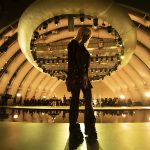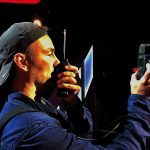 “I got real interested in all that stuff,” Cotter recalls, “and got to go to their shop on weekends to work with it.” He soaked up every watt of knowledge he could, working on high school productions and writing away for lighting catalogs.
“I got real interested in all that stuff,” Cotter recalls, “and got to go to their shop on weekends to work with it.” He soaked up every watt of knowledge he could, working on high school productions and writing away for lighting catalogs.
One of his high school tech teachers, Chuck Davis, also worked at Disneyland as a technical director. After graduation, Davis brought Cotter aboard the theme park’s technical services department, where he was able to move up to programming shows. There he met Jason Badger, whom he describes as “the guy” when it came to programming shows at Disney. “His expertise really shined in the programming of lighting for attractions and shows. The amount of care and detail he gave to his projects is truly unmatched. There is no one in the world better at what he does.” Badger primarily did shows for Brian Gale, the senior show lighting designer at Walt Disney Imagineering Show Lighting. Cotter soon also began programming for Gale and got to work several shows at Tokyo Disneyland. “Jason and I hit it off so well,” he says, “we started a company together in 2004 that’s called E-Ticket Studios in honor of our time at the Disney parks.”
 At the same time he was at Disney, Cotter also got a job at the Obie Company in the nearby city of Torrance, CA; one of the companies whose catalogs he’d requested. They’d sent him a packet of information on their tour lighting capabilities. (Obie merged with Winnipeg’s Westsun in 1999.) Though he describes his initial work as “just sweeping the shop,” it did offer some extras. “On weekends, I got to experiment in the demo room with whatever gear was in there at the moment.” He also managed to wedge in attending California State University, Long Beach, where three years as a business major did not deter him from his aspirations, though it probably contributed to the acumen needed to start his own firm.
At the same time he was at Disney, Cotter also got a job at the Obie Company in the nearby city of Torrance, CA; one of the companies whose catalogs he’d requested. They’d sent him a packet of information on their tour lighting capabilities. (Obie merged with Winnipeg’s Westsun in 1999.) Though he describes his initial work as “just sweeping the shop,” it did offer some extras. “On weekends, I got to experiment in the demo room with whatever gear was in there at the moment.” He also managed to wedge in attending California State University, Long Beach, where three years as a business major did not deter him from his aspirations, though it probably contributed to the acumen needed to start his own firm.
At Obie, he learned to operate and fix lighting rigs that were going out with the company’s touring customers. He remembers a watershed moment. “One of the staff lighting designers at Obie, Arnold Serame, happened into the demo room when I was in there. He was one of the first moving light programmers to do the big concert tours, like Michael Jackson, and one of the first people I saw doing what I wanted to do. He started helping me and teaching me what he knew, and it took off from there.” Cotter’s first console was the Compulite Animator, followed by the Wholehog II, then the Artisan. Today, he uses the PRG V676.
One day, the Obie shop manager asked Cotter if he’d like to go out on teen pop singer Brandy’s tour as a moving light tech. “Of course, I jumped at that, which led to other opportunities. On the tour, there would be opening acts that needed someone to run their lights, so the bands would pay me something like fifty bucks a night above my regular pay to light their shows.”
 More tours followed, and Cotter also continued his self-guided tutorials in the Obie demo room. “I’m basically one of those self-taught types,” he admits, but he doesn’t hesitate to give props to those he learned from. “Being on tours, I’d talk to people like Andy O’Riley, Harry Sangmeister and Matt Firestone to learn their philosophies on how to program certain effects or set up building blocks for programming more cues. Almost like a musician, I took bits and pieces from all the experts I encountered, then created my own style and workflow. Also, many of the manufacturers offer classes on the basic operation of their desks. I’d take those, then go off by myself, sit at a console and keep hitting buttons until I figured out what everything did.”
More tours followed, and Cotter also continued his self-guided tutorials in the Obie demo room. “I’m basically one of those self-taught types,” he admits, but he doesn’t hesitate to give props to those he learned from. “Being on tours, I’d talk to people like Andy O’Riley, Harry Sangmeister and Matt Firestone to learn their philosophies on how to program certain effects or set up building blocks for programming more cues. Almost like a musician, I took bits and pieces from all the experts I encountered, then created my own style and workflow. Also, many of the manufacturers offer classes on the basic operation of their desks. I’d take those, then go off by myself, sit at a console and keep hitting buttons until I figured out what everything did.”
At the time, tour lighting wasn’t viewed as the career choice it is today. Only a few people were doing it, because with the early technology, there wasn’t really that much to do. “Arnold was one of the guys at the forefront who established it as a career for people coming up a generation or two behind him,” notes Cotter. “I did more and more tours, including a Creed tour for Upstaging in the early 2000s, where I met Nook [Schoenfeld, lighting designer and now editor of PLSN] for the first time. He was a lot like Arnold in that he was happy to share his knowledge with anyone who was interested in lighting. I learned a lot about touring lighting from him. Not everyone is as willing to help someone out, promote their career, push them along. Some are afraid to give away information for fear of losing some kind of status or advantage.”
Nomad No More
By 2005, Cotter had wearied of life on the road, ending his touring career with Metallica. “It wasn’t the permanent life I wanted,” he explains. “I loved touring, it was a ton of fun, I learned a lot, I met amazing people. But I remember realizing that most of the people working tours probably only saw their families two or three months out of the year. That wasn’t for me. I didn’t want to turn 50 with two kids and a wife back home that I never saw.” Luckily, there was quite a lot of work for Disneyland waiting for him, including designing the lighting for the 50th anniversary fireworks show called “Remember, Dreams Come True.”
In addition to lighting for the castle, he and Chuck Davis were the first to use media servers in the park. As Cotter recounts, “Chuck was a strong proponent of technology in storytelling who really pushed using media and more high-tech elements in shows at the parks. Chuck really helped me to grow and take on more production- and design-based responsibilities on the new shows. My time at Disney really moved me into the video and media world. I credit Chuck for that. I was also fortunate to be part of the team that brought many upgrades to the show ‘Fantasmic’ at Disneyland, including the new LED barges, and upgrading the film projectors to digital projectors.” He considers the capstone of his Disney career his handling of the video on “The World of Color” at Disney’s California Adventure and being the video producer for “Fantasmic” at Tokyo DisneySea.
TV, or not TV
Soon, television came calling. “A company I’d worked tours with was Vari*Lite in Los Angeles. One of their field guys, Curry Grant, had called me several times about programming lights for a TV show. At the time, I was terrified of doing television because of how fast and furious it seemed. With a tour, you have weeks to prepare, program and process. But on live TV, you program the performances for the show that morning, do a dress rehearsal in the afternoon, run the show live in the early evening, and you’re driving home when it’s on the air.” Grant kept calling, and Cotter eventually relented (“mostly to get the phone calls to stop!”). He began his television career with a mercifully short-lived NBC program called Celebrity Circus. On it, seven ostensible celebrities spent eight weeks learning traditional circus stunts involving trapezes, high wires, animals, clown regalia, etc., which they then performed for scoring by judges and the home audience. Drama ensued, but ratings did not. Circus folded up its tent after only six episodes. “Live television was as crazed as I feared it would be,” Cotter remembers. “It was extremely nerve-wracking, but I got through it.” More TV jobs followed.
DWTS: Welcome, Matt
In one of those “simple twists of fate,” the lighting director on the Circus gig was Simon Miles, who would later become the lighting designer for Dancing with the Stars. When the lighting director of DWTS (as we say in the biz) Josh Hutchings left to join American Idol, Miles hired Cotter as programmer for the show’s seventh season. He has worked on every season since. In fact, after that rookie season, he didn’t realize that not being let go at its conclusion was a de facto invitation to return. He’d taken on some other work and got a frantic phone call from the show at the start of the eighth season, wondering where he was. They were saying, in essence (wait for it…), “Welcome back, Cotter.”
Now in its 21st season (there are two seasons per year), DWTS first tangoed, hip-hopped and foxtrotted into American living rooms, conversations and psyches in 2005 on ABC. Borrowing from the British show Strictly Come Dancing, it pairs alleged celebrities with professional dancers; the couples compete before judges and viewers after working for weeks on complex routines. “Star” is defined with considerable elasticity. The nearly 250 celeb hoofers have included boxers, pro NBA and NFL athletes, talk show hosts, multimillionaires, comedians, a magician, an astronaut, Olympians, the offspring of celebrities, and many acting, singing and modeling stars of varying brightness.
Dancing has become more complex over the years, and so has Cotter’s purview and participation. As Miles focused more and more on working with the producers and the director, planning camera shots, getting the correct color and managing all the key lighting and 12 followspots, Cotter became lighting director. With the added responsibility, the new position also gave him more creative input in partnership with the designer. “I get the music ahead of time,” he explains, “so for each song, I come up with an intro look, a verse look, a chorus look, a couple of hits, another verse, a chorus and a button. I’ll actually build all those cues with creative input from Simon.”
He finds the PRG 676 ideal for TV work, possibly because its pedigree dates back to Vari*Lite, the first manufacturer of computerized moving lights. “The original console was created almost like a garage project by tinkerers who could work closely with the people who would be operating it, since there were only two or three at the time. It grew from there, with each generation passing its knowledge down to the next. Since Vari*Lite knew a lot about lighting for television, this console became the unofficial standard for TV, just like the grandMA is the go-to desk for touring and concerts. There’s almost a PRG 676 ‘style,’ with subtle similarities in the work of people who have programmed on it. Likewise, if you were to look at my show files, you’ll find elements of people I’ve learned from. There are only about 20 colors that appear on live television, because the cameras can only see so much. So my color layout is pretty much the same one as my mentors used. My gobo palette is the same as the one Arnold gave me when he taught me the Hog II.”
In season 13 (2011), DWTS got a whole new set. “The show became 360°, with two tiers of audience with balconies. So it isn’t just about cameras downstage, the band upstage and the dancers in between. Now there are cameras downstage pointing upstage, cameras upstage pointing downstage, a wireless spinning cam, cameras left and right on the floor, four hand-held cameras that go anywhere, a remote camera in the ceiling that points straight down at the dancers, fixed cameras on the judges…it just exploded! It makes lighting very complicated.
“Before, the cameras and lights pointed mostly in one direction, from the point of view of the audience. Now, with more cameras shooting in every direction, often with quick reversals, keylights can abruptly become backlights, and backlights can abruptly become keylights. If you’re backlighting a dancing couple with a red or blue light and the camera turns around, you suddenly get very unattractive red or blue faces. You have to know where the director’s going or be able to make very fast transitions. I sit stage right, kind of hidden under one of the balconies, watching a program monitor to see where the director is going and a 30-inch multiviewer monitor with all the cameras on it so I can see at a glance what each camera is shooting. Simon, the designer, sits in the control booth with the director, feeding me directions over my headset.”
“Before each show, we have a camera-blocking day in which all the expected camera moves are scripted based on rehearsal videos of the dancers. We then create lighting looks that match well with each camera shot — long shot, wide shot, close-up, silhouette. Dancers who are more experienced with television will have specific ideas for what they want, too.”
The program goes live at 5 p.m. Pacific time for airing at 8 p.m. on the East Coast. It must fill exactly two hours, with commercial breaks precisely on schedule. “In a perfect world,” says Cotter, “I’d just sit there and run the lights and everything would go flawlessly. That happens about a quarter of the time. There are always unexpected moments, such as when couples dance out of the light or the host walks in an unplanned direction. It becomes apparent very quickly when someone on camera is not lit, so we have to always be ready with alternatives. And because it’s a competition show, the dancers aren’t allowed to re-do their dances for the next time zone. Once it’s done, it’s done, and I’m home (in the city of Orange, CA), by the time the show airs on the West Coast.”
Because Dancing’s seasons are 11 weeks long, Cotter has plenty of time to take on freelance lighting design and programming work, including awards shows (Grammys, BET, Oscars, Kids Choice), corporate events, system design for large-scale Disney spectaculars, and even filling in on the program So You Think You Can Dance. His partnership, E-Ticket Studios, also takes on projects including media and lighting design, content creation, programming services, in-house animation and equipment rental for entertainment events, shows and productions.
Dancing with the Stars has won a dozen production Emmy Awards during its tenure, with one in 2014 for “Outstanding Lighting Design/Lighting Direction For A Variety Series” that specifically names Cotter and his colleagues Simon Miles and Suzanne Sotelo. As proud as he was of the award, Cotter was even more excited about being able to take his parents to the creative arts awards events (the week before the primetime awards telecast). His mother and mother-in-law, awed by the stars in attendance, and his father, were finally convinced that, yes, entertainment lighting is a real career.
For more information, visit www.eticketstudios.com.


